A Disciplinary Action Form is a document that outlines the violation of company policies or job responsibilities by an employee. This form serves as a record of the issue, the actions taken by the employer, and any consequences for the employee.
Table of Contents
Purposes of Disciplinary Action Forms

A Disciplinary Action Form serves several important purposes in the workplace, including:
Documenting workplace violations: The Disciplinary Action Form provides a clear and formal record of any violations of company policies or job responsibilities by an employee. This documentation can be used as evidence in legal proceedings or as a reference for future performance evaluations.
Maintaining a consistent disciplinary process: By using a Disciplinary Action Form, employers can ensure that they are following a consistent and fair process for addressing workplace violations. This can help to avoid any potential legal issues or conflicts with employees.
Communicating expectations and consequences: The Disciplinary Action Form outlines the specific violation, the actions taken by the employer, and any consequences for the employee. This helps to clearly communicate the expectations for behavior in the workplace and the consequences for failing to meet those expectations.
Improving employee performance: The Disciplinary Action Form can serve as a tool for improving employee performance by providing clear feedback and guidance for areas that need improvement. This can help employees to understand their responsibilities and make necessary changes to improve their performance.
Protecting the company’s interests: By documenting workplace violations, employers can protect the company’s interests and avoid potential legal issues in the future. The Disciplinary Action Form serves as proof that the employer has taken appropriate actions to address workplace violations and enforce company policies.
Disciplinary Action Form Templates
A disciplinary action form is a document used by managers and HR when an employee misconduct issue needs to be addressed. These forms are used to provide written documentation of the disciplinary process. There are standard disciplinary action form templates available that allow employers to record details of the issue.
The disciplinary action form will state the date, the name of the employee involved, and specifics of the policy violation or performance issue. Details are provided such as dates of occurrences, previous warnings given, and impact of the employee’s actions. The form outlines the disciplinary measures being taken, which may include verbal warning, written warning, suspension, or termination.
The employee is presented with the completed disciplinary action form and asked to sign it. Their signature indicates they have been informed of the issue and the disciplinary action, not that they necessarily agree with the action. The form becomes part of the employee’s personnel file. Well-documented disciplinary action forms create a record in case further discipline is needed. They also protect the company in case of legal action.
When to use a disciplinary action form
A Disciplinary Action Form should be used whenever an employee violates company policies or job responsibilities. Some common reasons for using a Disciplinary Action Form include:
Attendance violations: Failing to show up for work or missing too many days without a valid excuse.
Performance issues: Failing to meet performance standards or consistently failing to complete job duties.
Harassment or discrimination: Engaging in harassing or discriminatory behavior towards coworkers or customers.
Substance abuse: Using drugs or alcohol at work or coming to work under the influence.
Theft or misuse of company property: Stealing or misusing company property, equipment, or resources.
Insubordination: Refusing to follow company policies, procedures, or instructions from a supervisor.
Confidentiality breaches: Sharing confidential information without proper authorization.
It is important to use a Disciplinary Action Form whenever a workplace violation occurs to document the violation, communicate the consequences, and maintain a consistent disciplinary process. The Disciplinary Action Form should be used in conjunction with other steps, such as verbal warnings or performance improvement plans, to address the violation and improve employee performance.
What to include in a disciplinary action form
A Disciplinary Action Form should include the following information:
Employee information: Name, job title, and employee ID number.
Date of violation: The date the violation occurred.
Description of violation: A detailed description of the policy, procedure, or job responsibility that the employee violated.
Supporting evidence: Any documentation, witness statements, or other evidence that supports the violation.
Disciplinary action taken: A description of the disciplinary action taken, such as a verbal warning, written warning, or suspension.
Signature of employee: A signature line for the employee to acknowledge receipt of the disciplinary action.
Signature of supervisor: A signature line for the supervisor to indicate approval of the disciplinary action.
Follow-up plan: A plan for monitoring the employee’s performance and behavior in the future.
Next steps: A description of any additional steps that may be taken if the employee does not improve their performance or behavior.
Including all of this information in the Disciplinary Action Form helps to ensure that the disciplinary process is transparent, consistent, and fair for all employees. It also provides documentation of the disciplinary action for future reference, if necessary.
Types of Disciplinary Actions
There are several types of disciplinary actions that can be taken in response to a workplace violation. Some common types of disciplinary actions include:
Verbal warning: A discussion between the employee and supervisor about the violation and the expectation for improvement.
Written warning: A formal written document outlining the violation and the consequences if the violation is not corrected.
Suspension: A temporary removal from the job, without pay, for a specified period of time.
Demotion: A reduction in job title or responsibilities as a result of performance or behavior issues.
Termination: The termination of employment due to persistent or severe violations of company policies or job responsibilities.
The type of disciplinary action taken will depend on the severity of the violation, the employee’s prior disciplinary history, and the company’s policies and procedures. It is important to use a consistent disciplinary process and document all disciplinary actions to ensure that the process is fair and transparent for all employees.
How to fill out a disciplinary action form
To fill out a Disciplinary Action Form, follow these steps:
Enter employee information: Start by entering the employee’s name, job title, and employee ID number.
Describe the violation: Clearly describe the policy, procedure, or job responsibility that the employee violated. Be specific and include dates, times, and other relevant details.
Provide supporting evidence: Attach any documentation, witness statements, or other evidence that supports the violation.
Record the disciplinary action taken: Clearly describe the disciplinary action taken, such as a verbal warning, written warning, or suspension.
Obtain signatures: Have the employee sign the form to acknowledge receipt of the disciplinary action. The supervisor should also sign the form to indicate approval of the disciplinary action.
Make a follow-up plan: Outline a plan for monitoring the employee’s performance and behavior in the future. This should include the steps that will be taken if the employee does not improve.
Review and file the form: Carefully review the form to ensure that all information is accurate and complete. Then, file the form in a secure location for future reference, if necessary.
By following these steps, you can ensure that the disciplinary process is well-documented and consistent, and that the disciplinary action taken is fair and transparent for all employees.
How to Make Your Own Disciplinary Action Form
To make your own Disciplinary Action Form, follow these steps:
Determine the information you need to include: Consider the information that you need to collect, such as employee information, details about the violation, the disciplinary action taken, and follow-up plans.
Choose a format: You can create a disciplinary action form using a word processing software or a spreadsheet program. Choose the format that works best for you and your organization.
Create a header: Include a header with your company name and the title “Disciplinary Action Form.”
Include the necessary fields: Add fields for employee information, such as name, job title, and employee ID number. Include fields for describing the violation and the disciplinary action taken, and fields for signatures.
Make the form visually appealing: Use formatting tools, such as bold text and shading, to make the form visually appealing and easy to read.
Test the form: Test the form by filling it out with dummy data to make sure that it works as you intended. Make any necessary adjustments.
Save and distribute the form: Save the form in a secure location and distribute it to the appropriate individuals in your organization, such as managers and supervisors.
Types of Unacceptable Conduct Warranting Disciplinary Measures
Disciplinary action may be necessary for a variety of forms of misconduct, including but not limited to:
Insubordination or disobedience to superiors or company policies: This refers to a failure to comply with instructions or directions given by a supervisor or manager, or a refusal to follow company policies and procedures.
Theft or fraud: This refers to the unauthorized taking of property or assets belonging to the company, or any form of deception or dishonesty intended to benefit oneself or harm the company.
Harassment or discrimination: This refers to any behavior that creates a hostile work environment for an individual or group, including harassment based on race, gender, religion, age, or other protected characteristics.
Substance abuse on the job: This refers to the use of drugs or alcohol during work hours, or reporting to work under the influence of drugs or alcohol.
Unexcused absence or tardiness: This refers to missing work without prior approval or notification, or failing to report to work on time.
Sabotage or damage to company property: This refers to intentional acts of destruction or harm to company property, equipment, or facilities.
Conflicts of interest: This refers to situations where an employee’s personal interests interfere with their responsibilities to the company, such as taking on work for a competitor or using company resources for personal gain.
Unprofessional conduct or behavior: This refers to actions that are inconsistent with the norms and expectations of professional behavior, such as dishonesty, insensitivity, or uncooperative behavior.
Violation of company policies and procedures: This refers to any failure to comply with the policies and procedures established by the company, such as those related to safety, confidentiality, or use of company resources.
Use of company resources for personal gain: This refers to the unauthorized use of company resources, such as time, equipment, or materials, for personal benefit or advantage.
FAQs
Can a disciplinary action form be used for both written and verbal warnings?
Yes, a disciplinary action form can be used for both written and verbal warnings, but it is important to document the steps taken in each instance.
Are disciplinary action forms legally binding?
Disciplinary action forms can be legally binding, but it depends on the specific circumstances and laws in your jurisdiction. It is important to consult with legal counsel to determine the best course of action.
Can a disciplinary action form be used for positive feedback and recognition?
Yes, a disciplinary action form can be adapted to include positive feedback and recognition. It can be used to document instances where an employee has gone above and beyond expectations, or to formally recognize an employee for their contributions.
Is it necessary to have an employee sign the disciplinary action form?
Yes, it is generally recommended to have the employee sign the disciplinary action form as an acknowledgement of receipt and understanding of the disciplinary measure.
Can a disciplinary action form be used for terminating an employee?
Yes, a disciplinary action form can be used as part of the process for terminating an employee, but it is important to consult with legal counsel and follow all applicable laws and procedures.
How should disciplinary action forms be stored and maintained?
Disciplinary action forms should be stored in a secure location and maintained in accordance with your company’s HR policies and applicable laws.
What are the potential consequences of not having a disciplinary action form?
Without a disciplinary action form, it may be difficult to prove that proper steps were taken in response to employee misconduct. This can leave your company vulnerable to legal disputes and employee grievances.







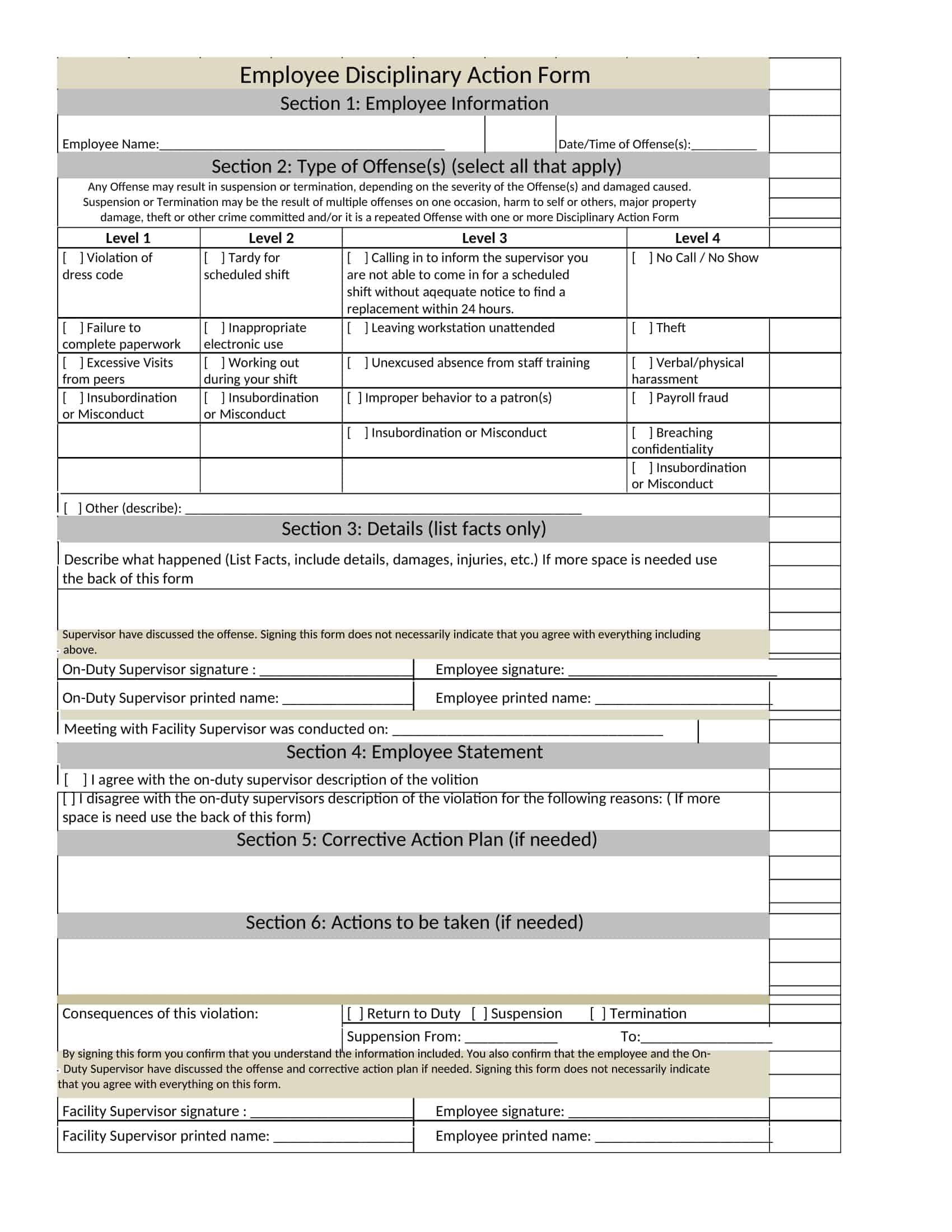






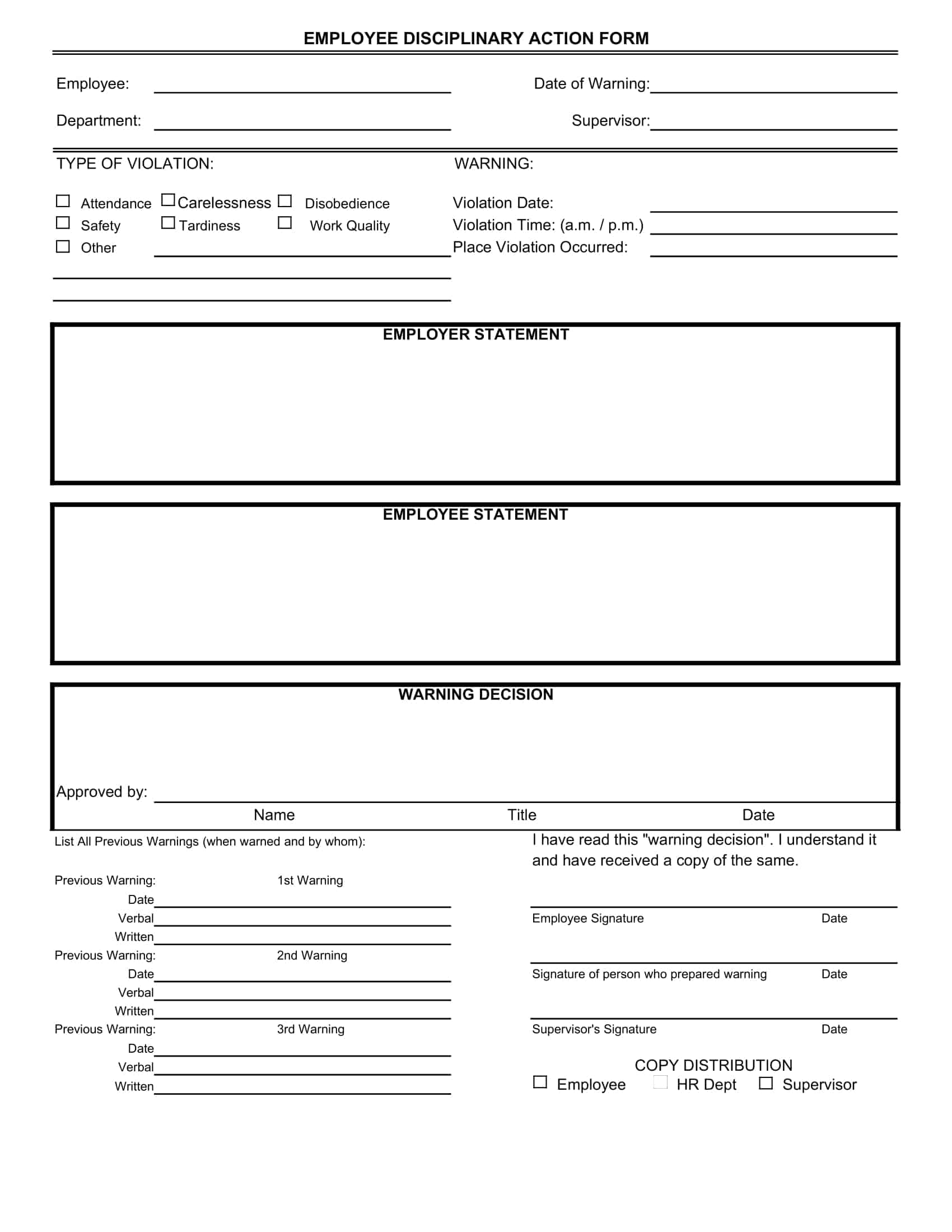



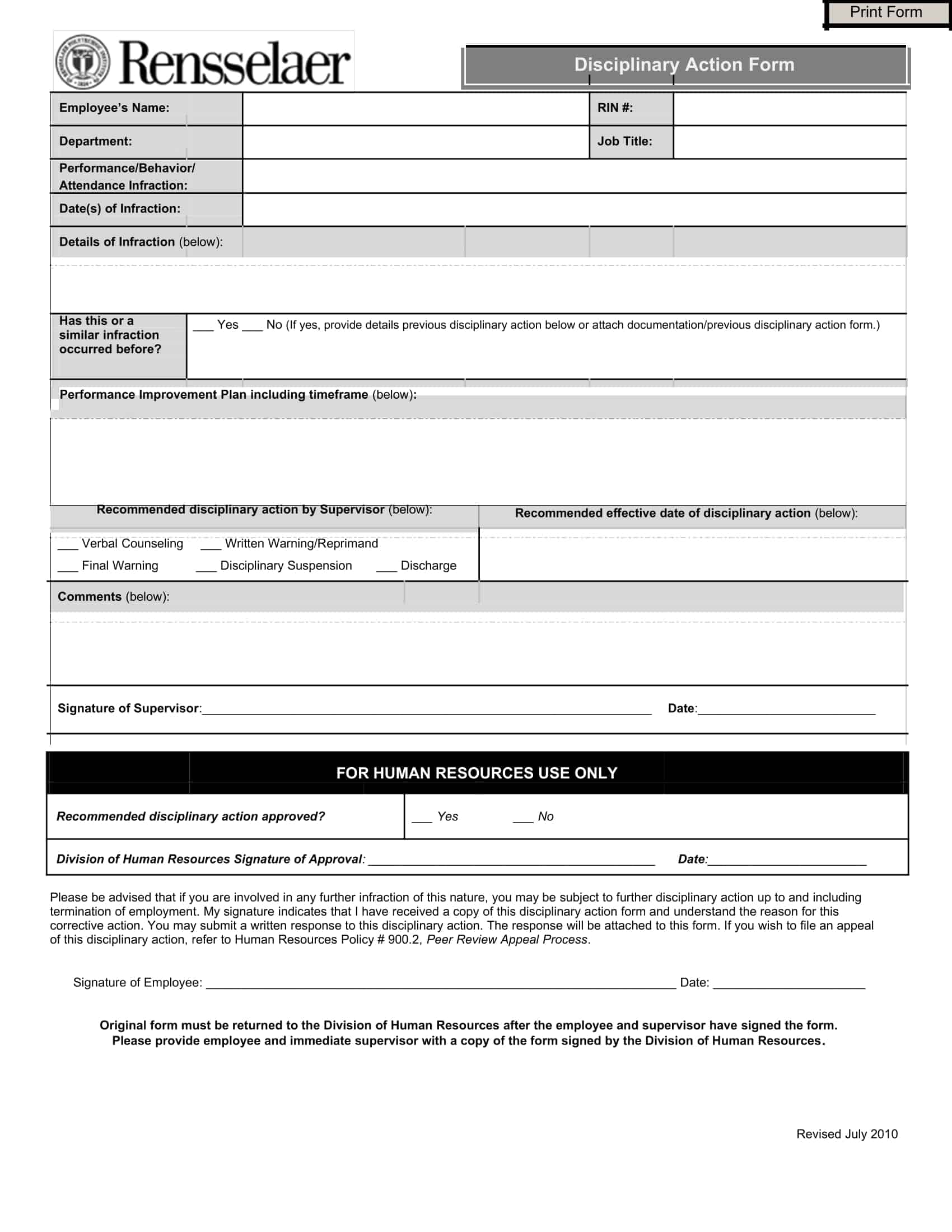







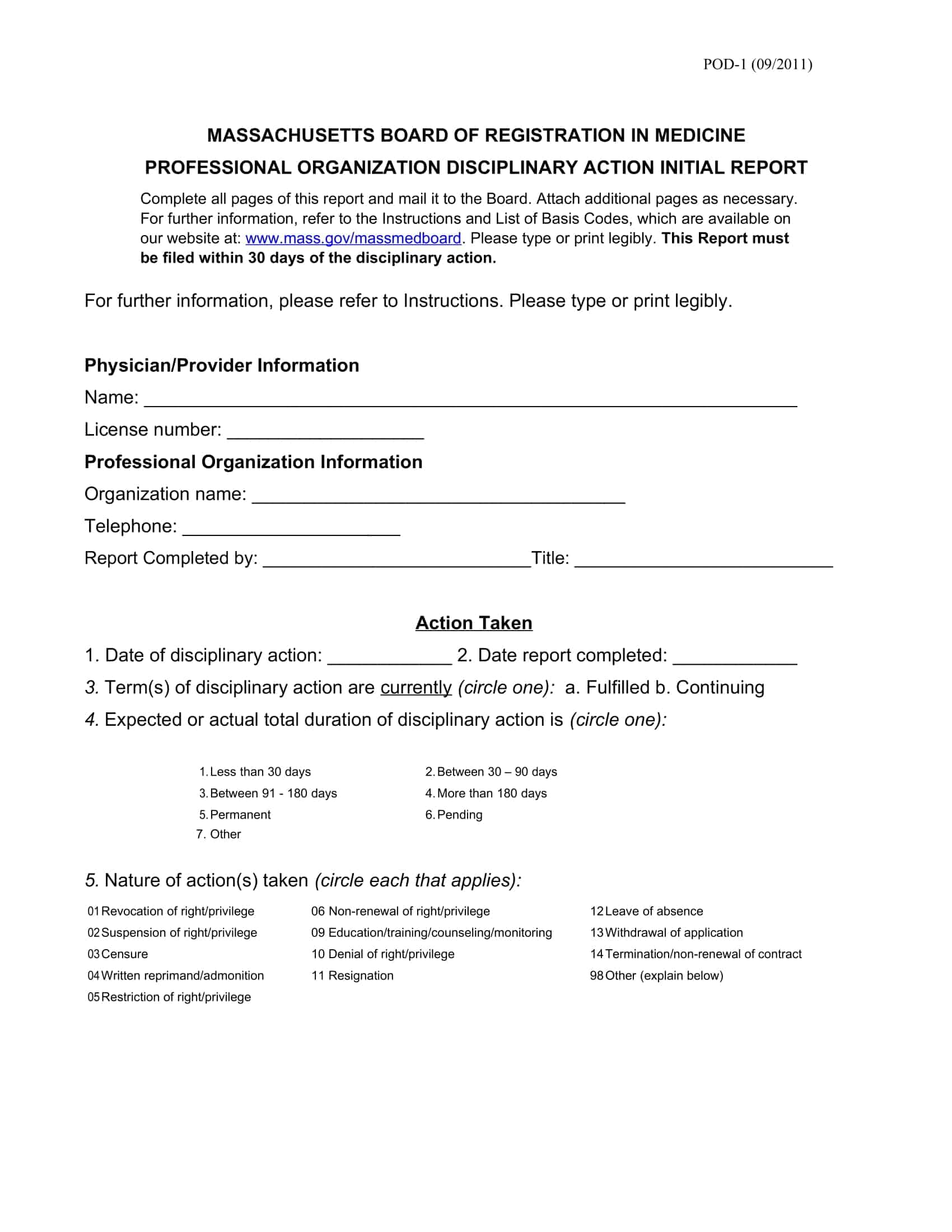












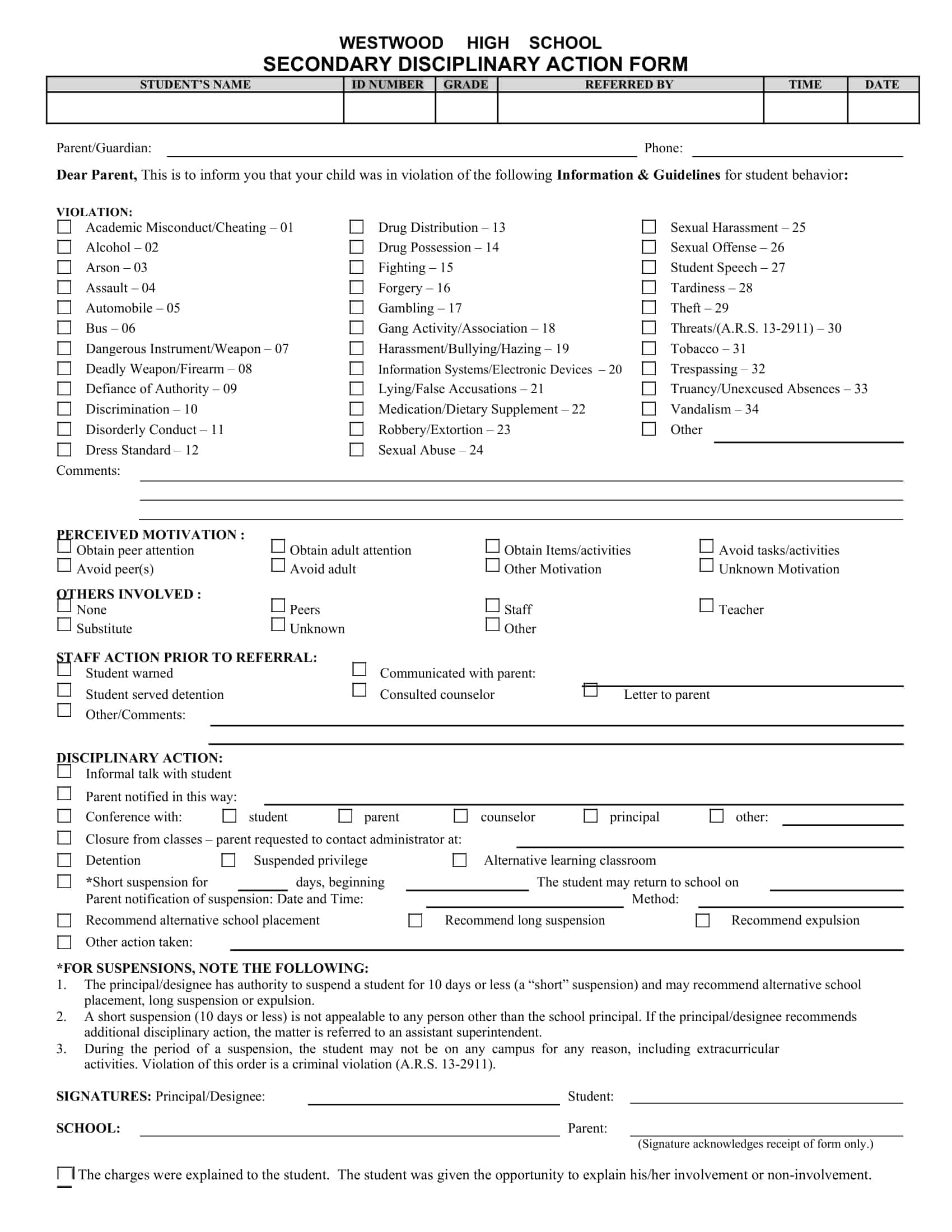
![%100 Free Hoodie Templates [Printable] +PDF 1 Hoodie Template](https://www.typecalendar.com/wp-content/uploads/2023/05/Hoodie-Template-1-150x150.jpg)
![Free Printable Location Release Form Templates [PDF, Word] Property / Example 2 Location Release Form](https://www.typecalendar.com/wp-content/uploads/2023/05/Location-Release-Form-1-150x150.jpg)
![Free Printable Talent Release Form Templates [PDF, Word, Excel] 3 Talent Release Form](https://www.typecalendar.com/wp-content/uploads/2023/05/Talent-Release-Form-1-150x150.jpg)
